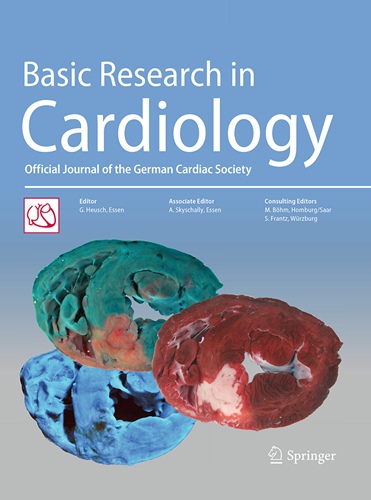Chemokine-receptor-guided B-cell immunity in cardiovascular disease.
IF 8
1区 医学
Q1 CARDIAC & CARDIOVASCULAR SYSTEMS
引用次数: 0
Abstract
Cardiovascular diseases (CVD) include a wide range of disorders affecting the heart and blood vessels, many of which are associated with atherosclerosis. Atherosclerosis is the main underlying cause of CVDs and represents a chronic inflammatory disease of the large arteries involving the build-up of plaques within the arterial wall. B cells play a dual role in CVD, particularly in the context of atherosclerosis, by producing antibodies and secreting cytokines that modulate inflammation. Depending on their subtype (B1 vs. B2 cells) and the specific context, B cells can have both protective and harmful effects on the cardiovascular system. B1 cells, which arise predominantly during fetal development, are found in body cavities, such as the perivascular adipose tissue (PVAT) and peritoneum. Guided by CXCL13 and CCR6, they migrate to sites, where they produce IgM and IgG3, contributing to immune regulation and pathogen defense. In contrast, B2 cells-central players in adaptive immunity-originate in the bone marrow and mature in secondary lymphoid organs. Within this subset, marginal-zone (MZ) B cells provide rapid, low-affinity IgM responses to blood-borne antigens, while follicular (FO) B cells mediate high-affinity, T-cell-dependent antibody production. For all of the latter chemokine-guided migration is essential for B-cell function, from immune surveillance to antibody secretion. Receptors such as CXCR4, CXCR5, and ACKR3 not only direct B-cell trafficking but also influence their phenotype in cardiovascular disease. Understanding how these chemokine-receptor interactions shape B-cell-mediated immunity in CVD may allow for developing targeted therapies for atherosclerosis, myocardial infarction, and stroke.趋化因子受体引导的b细胞免疫在心血管疾病中的作用。
心血管疾病(CVD)包括一系列影响心脏和血管的疾病,其中许多与动脉粥样硬化有关。动脉粥样硬化是心血管疾病的主要潜在病因,是大动脉的一种慢性炎症性疾病,涉及动脉壁内斑块的积聚。B细胞在心血管疾病中发挥双重作用,特别是在动脉粥样硬化的情况下,通过产生抗体和分泌调节炎症的细胞因子。根据其亚型(B1与B2细胞)和特定环境,B细胞对心血管系统既有保护作用,也有有害作用。B1细胞主要在胎儿发育期间产生,存在于体腔,如血管周围脂肪组织(PVAT)和腹膜。在CXCL13和CCR6的引导下,它们迁移到产生IgM和IgG3的位点,参与免疫调节和病原体防御。相比之下,B2细胞——适应性免疫的核心参与者——起源于骨髓,成熟于次级淋巴器官。在这个亚群中,边缘区(MZ) B细胞对血源性抗原提供快速、低亲和力的IgM反应,而滤泡(FO) B细胞介导高亲和力、依赖t细胞的抗体产生。对于所有后者的趋化因子引导迁移是必不可少的b细胞功能,从免疫监视抗体分泌。受体如CXCR4、CXCR5和ACKR3不仅直接b细胞运输,而且在心血管疾病中影响其表型。了解这些趋化因子受体相互作用如何在CVD中形成b细胞介导的免疫,可能有助于开发针对动脉粥样硬化、心肌梗死和中风的靶向治疗。
本文章由计算机程序翻译,如有差异,请以英文原文为准。
求助全文
约1分钟内获得全文
求助全文
来源期刊

Basic Research in Cardiology
医学-心血管系统
CiteScore
16.30
自引率
5.30%
发文量
54
审稿时长
6-12 weeks
期刊介绍:
Basic Research in Cardiology is an international journal for cardiovascular research. It provides a forum for original and review articles related to experimental cardiology that meet its stringent scientific standards.
Basic Research in Cardiology regularly receives articles from the fields of
- Molecular and Cellular Biology
- Biochemistry
- Biophysics
- Pharmacology
- Physiology and Pathology
- Clinical Cardiology
 求助内容:
求助内容: 应助结果提醒方式:
应助结果提醒方式:


